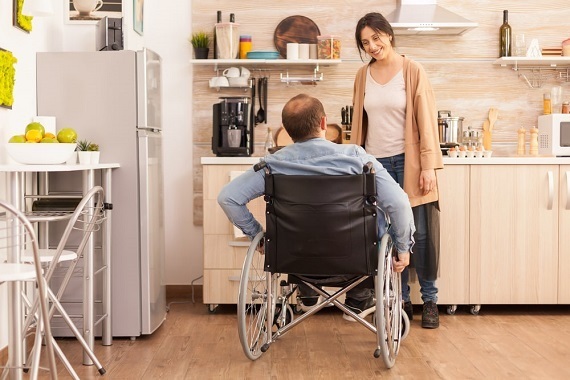When caring for a disabled family member, making the home accessible can seem like an impossible task. The government has already issued guidelines to make commercial buildings and offices accessible for disabled individuals. The same cannot be said for individual homes. So, you have to work on making your home friendly to family members who are disabled.
Here are some ways for you to increase accessibility in your home.
Table of Contents
Install ramps or wider doorways to make it easier for wheelchair-bound family members to get around.
Installing ramps and wider doorways is a great way to make your home more accessible for disabled family members. Ramps can be installed on both the front and back entrances of your home, and they are a great way to avoid having to use stairs.
Wider doorways can also be very helpful, as they will allow wheelchair-bound family members to move around more easily. You may also want to consider installing elevators, as they can be very helpful for those who have difficulty climbing stairs. Finally, you should think about creating wheelchair-accessible living spaces, which will allow your loved one to live independently.
Maintain an elevator in the home to give disabled individuals access the different floors without having to climb stairs
Maintaining a residential elevator is a great way to ensure that your loved one can access different floors without having to climb stairs. Even if you have only one level, installing the equipment for just yourself and your family members who are disabled can be very helpful. You should also consider creating wheelchair-accessible living spaces that allow your loved one to live independently.
Make your home accessible for those with hearing loss by installing a communication board.
A communication board is a great way to ensure that your loved one can communicate easily and effectively in their hand, or they can hand write messages on the board.
With a communication board, you do not have to worry about frustrating misunderstandings. You should also consider installing hearing loops, which will make it easier for your loved one to hear what’s going on without having to turn up the volume on the TV or radio.
Ensure that bathrooms have a low sink and a shower with a transfer bench
Making your home accessible means making sure that all of its parts are accessible for individuals with disabilities. This includes the bathroom, where you should consider adding a low sink and installing a shower with a transfer bench. Low sinks can help save your loved one’s energy, as they do not have to bend over very far just to wash their hands or brush their teeth. Showers with transfer benches will help those who find it very difficult to stand or those with limited balance. You may also want to consider adding a grab bar to the shower so that your loved ones can hold on and maintain their balance while getting in and out of the shower.
Enlarge or install mirrors to make rooms appear larger for family members with reduced vision.
Enlarging or installing mirrors is a great way to make rooms appear larger and more welcoming for family members with reduced vision. Mirrors can do wonders when it comes to making a home feel bigger and more open, so you should consider exploring this option.
Adding adequate lighting in hallways and staircases is also a great way to make your home more accessible for family members with disabilities. Ensuring that there is enough light will prevent falls, which could be potentially dangerous or even fatal. You can also add motion-activated lights so that you do not have to worry about turning the lights on and off when you or your loved one is in a hurry.
Create a “quiet room” in the house where individuals can go to relax when they are feeling agitated.
Creating a quiet room for your loved one is a great way to make their home more accessible and comfortable. A quiet room can be anything from an unused bedroom to a sun porch or patio, and it should be decorated in colors that will help relax your family member when they need some time alone.
Locate electrical outlets at an accessible height for individuals who use wheelchairs.
Another thing to consider when making your home more accessible is to locate electrical outlets at an accessible height for individuals who use wheelchairs. This will help eliminate the need for using extension cords, which can be very dangerous if not used properly. You should also think about installing power-operated doors and windows to make your loved one’s life easier.
If you want to make your home more accessible for a family member who is disabled, there are plenty of ways that you can do so. By taking the time to consider these changes and making them in stages, over time your loved one will be able to live comfortably in their own home without any assistance from others.

